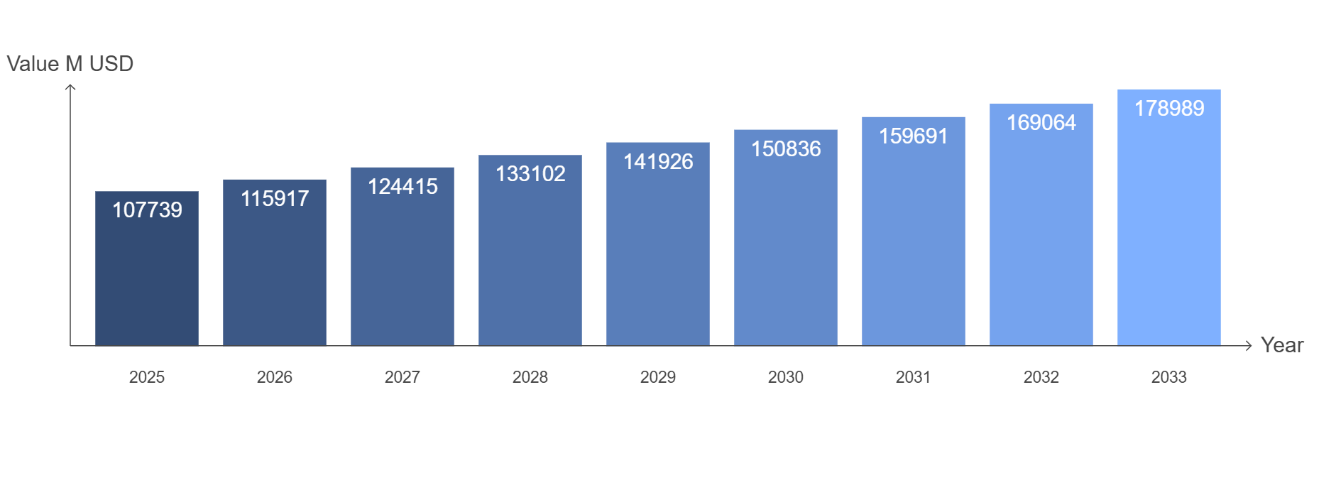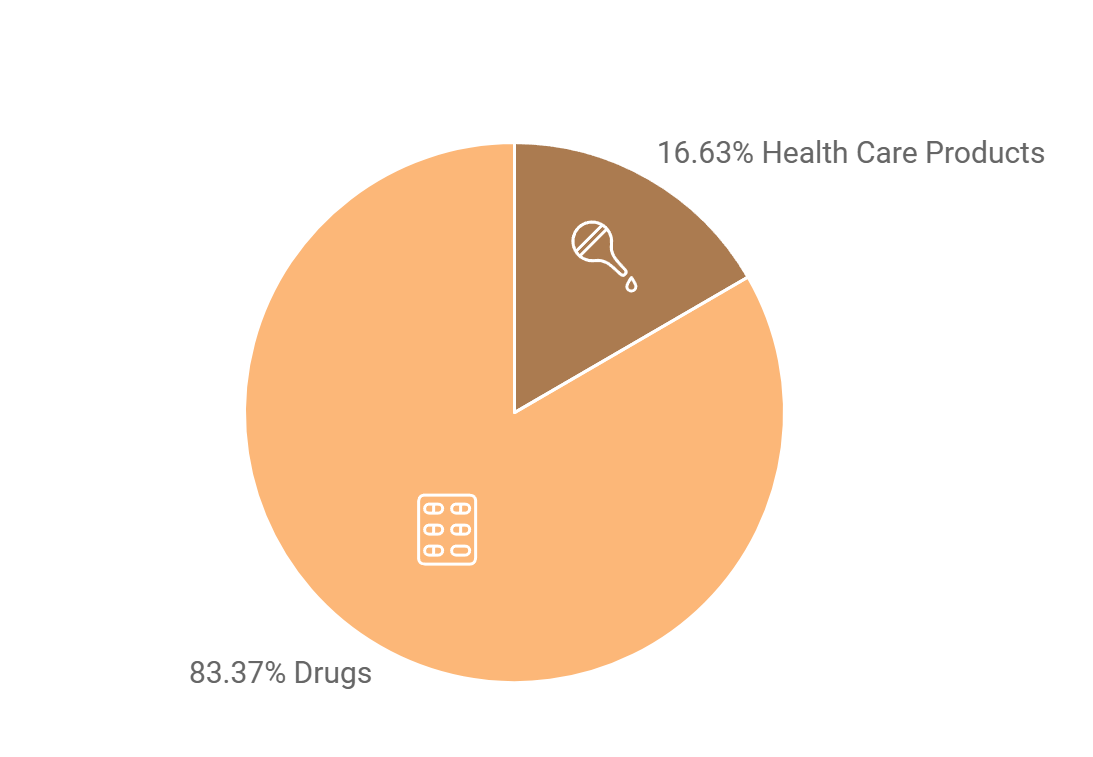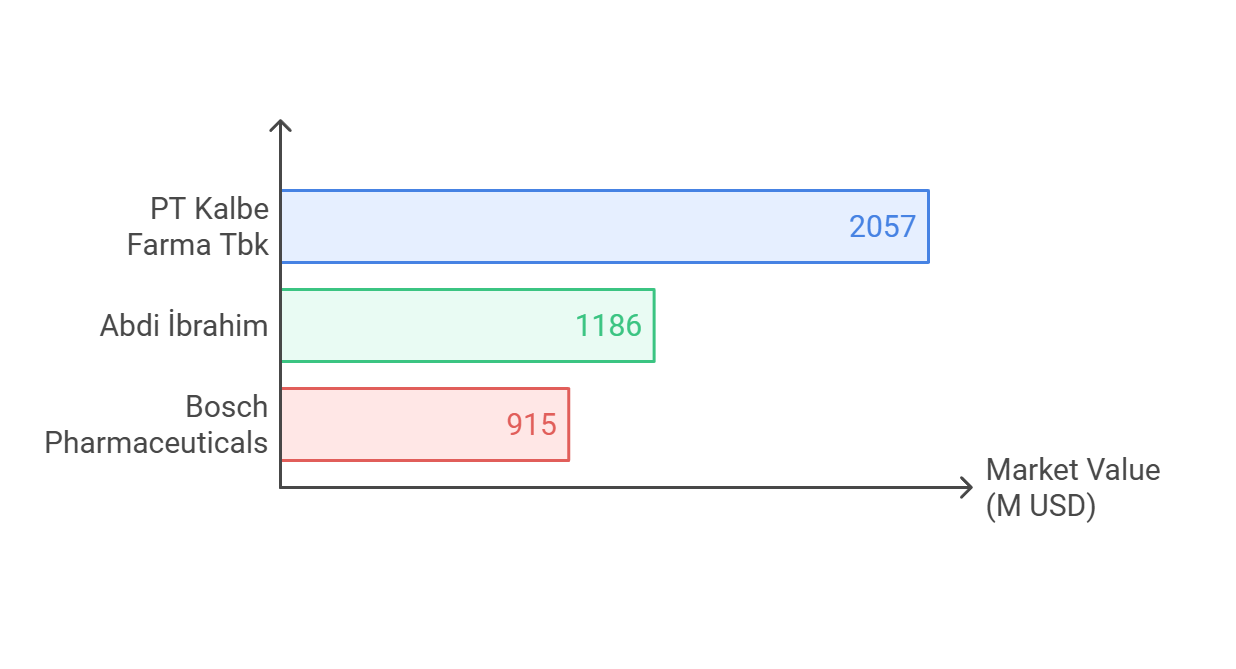1. Global Halal Pharmaceuticals Market Size and Market Definition
Halal pharmaceuticals are medicines that comply with the Islamic law and do not contain any ingredients that are forbidden (haram) such as alcohol, pork, or animal-derived substances. Halal pharmaceuticals are expected to maintain high standards of quality and purity throughout its manufacturing and packaging process, which is also why they are considered to be safe and effective.
Global Halal Pharmaceuticals market is projected to grow robustly from 2025 to 2033, with an expected Compound Annual Growth Rate (CAGR) of approximately 6.78%, reaching from $107.739 billion in 2025 to an estimated $178.989 billion in 2033. This CAGR indicates a consistent and significant expansion in the market size over the given period, reflecting a positive and upward trend in the Halal pharmaceuticals industry on a global scale.
Figure Global Halal Pharmaceuticals Value (M USD) and Growth Rate from 2025-2033

2. Halal Pharmaceuticals Market Dynamic Analysis
Market Drivers:
‘The growing number of Muslims’
Muslims are a general term for all people who believe in the teachings of Islam. Public data shows that in the global market, there are a total of 57 countries and regions where Islam is the state religion and most residents believe in Islam. Statistics released by relevant United Nations agencies show that the total number of Muslims (i.e. Islamists) in the world exceeded 1.8 billion in 2021, accounting for approximately 1/4 of the world’s total population. According to the agency’s projections, by 2030, the total population of Muslims in the world will increase to 2.2 billion.
Muslims abide by Islamic rules, so the food, medicines and other products they consume cannot contain ingredients that are inconsistent with Islamic rules. Halal Pharmaceuticals refers to medicines that comply with Islamic law and do not contain any prohibited ingredients such as alcohol, pork or substances of animal origin. In the field of medicine, Muslim consumers have special needs in this area that are different from non-Muslim consumers. Due to religious beliefs and other reasons, Muslim consumers will choose to buy Halal Pharmaceuticals products. Therefore, as the number of Muslims continues to increase, the market demand for Halal Pharmaceuticals continues to increase, thereby promoting market development.
Market Threat:
‘Risks of counterfeit and shoddy products’
Since Halal Pharmaceuticals has complex requirements for raw material ingredients and production processes, relevant agencies may face a series of difficulties in supervising raw materials and production processes. First, in relatively underdeveloped Muslim countries, some manufacturers purchase large quantities of raw materials and process them into preparations in order to reduce costs. Halal Pharmaceuticals must not contain any ingredients derived from pigs, alcohol, blood, human organs or insects. Animal-derived ingredients must come from animals that are permitted to be slaughtered and slaughtered in accordance with methods prescribed by Islamic law. During preparation, processing, handling, packaging, storage and distribution, Halal Pharmaceuticals are required to handle separately from pharmaceutical ingredients that do not meet the above requirements. And the raw materials may not necessarily meet the production requirements of the canon. This results in the fact that the Halal Pharmaceuticals advertised on the market may not actually be the real Halal Pharmaceuticals. In order to better develop the Halal Pharmaceuticals market, it is necessary to ensure that halal drugs undergo good management and halal certification procedures to ensure the compliance of Halal Pharmaceuticals. The risk of counterfeit and shoddy products is one of the risks and threats facing market development.
Market Opportunities:
‘Rising income levels of Muslims’
Halal products are rapidly gaining recognition around the world as the new benchmark in safety and quality assurance. Nowadays, halal products focus not only on food but also on all products including pharmaceuticals. As the number of Muslims continues to increase and Muslim people’s disposable income increases, their purchasing power continues to increase, and people’s expenditures in the field of medicine continue to increase. For example, as people’s disposable income increases in Indonesia, Malaysia and other regions, the market demand for Halal Pharmaceuticals increases. In addition, in the development of a society that pays more and more attention to health and wellness, Halal Pharmaceuticals are also becoming more and more popular among non-Muslims. These factors will bring opportunities to the development of the Halal Pharmaceuticals market.
‘Strengthening the certification management of Halal Pharmaceuticals’
In order to better regulate the quality of Halal Pharmaceuticals, Halal Pharmaceuticals companies need to obtain approval from relevant agencies for the production of Halal Pharmaceuticals and obtain drug halal certification. At present, many regions such as Indonesia and Makkia have introduced relevant policies to improve the production and certification supervision of Halal Pharmaceuticals. Improve the quality and credibility of Halal Pharmaceuticals through policies, ensure the healthy and sustainable development of the halal product market, and meet consumer demand for halal products. Strengthening the certification management of Halal Pharmaceuticals can provide Halal Pharmaceuticals with more standardized and good development opportunities.
3. Global Halal Pharmaceuticals Revenue and Share by Type (2020-2025)
From 2020 to 2025, the global Halal Pharmaceuticals market has seen a notable increase in revenue across different product types. Tablets have maintained the largest share with a revenue growing from $22,893 million in 2020 to a projected $40,981 million in 2025, reflecting the highest growth rate among all types. Syrups and Capsules also show significant growth, with revenues expanding from $8,540 million and $19,479 million in 2020 to $14,263 million and $31,268 million respectively by 2025. While “Others” category starts from $13,140 million in 2020 and is expected to reach $21,227 million by 2025.
In 2025, the Halal Pharmaceuticals market is led by Tablets with a 38.04% share, followed by Capsules at 29.02%, Syrups at 13.24%, and Others at 19.70%, indicating a balanced yet dominant presence of Tablets in the global market.
Table Global Halal Pharmaceuticals Revenue (M USD) by Types (2020-2025)
| 2020 | 2021 | 2022 | 2023 | 2024 | 2025 |
Tablets | 22893 | 26845 | 29032 | 33663 | 37671 | 40981 |
Syrups | 8540 | 9781 | 10472 | 11949 | 13229 | 14263 |
Capsules | 19479 | 22034 | 23513 | 26440 | 28976 | 31268 |
Others | 13140 | 14907 | 15929 | 18038 | 19827 | 21227 |
Total | 64052 | 73567 | 78946 | 90090 | 99703 | 107739 |
Figure Global Halal Pharmaceuticals Revenue Share by Types in 2025

4. Global Halal Pharmaceuticals Revenue and Share by Application (2020-2025)
In 2025, the global Halal Pharmaceuticals market is segmented by applications into Health Care Products and Drugs. Health Care Products are projected to generate a revenue of $17,920 million, capturing a market share of approximately 16.63%. Meanwhile, Drugs are expected to dominate the market with a revenue of $89,818 million, accounting for about 83.37% of the total market. This distribution highlights the significant contribution of the Drugs segment to the overall Halal Pharmaceuticals market, reflecting its substantial demand and importance within the industry.
Table Global Halal Pharmaceuticals Revenue by Applications (2020-2025)
| 2020 | 2021 | 2022 | 2023 | 2024 | 2025 |
Health Care Products | 10111 | 11732 | 12700 | 14768 | 16571 | 17920 |
Drug | 53941 | 61835 | 66247 | 75322 | 83132 | 89818 |
Total | 64052 | 73567 | 78946 | 90090 | 99703 | 107739 |
Figure Global Halal Pharmaceuticals Revenue Share by Applications in 2025

5. Global Halal Pharmaceuticals Market Revenue Comparison by Region
North America’s share in 2020 was $2838 million, showing a gradual increase to $4404 million by 2025. Europe also exhibited growth, starting from $4969 million in 2020 and reaching $7123 million in 2025. The Asia-Pacific region, which is a significant contributor to the global Halal pharmaceuticals market, began with $27626 million in 2020 and is projected to reach $47144 million by 2025, reflecting the region’s substantial market potential and growth.
The Middle East and Africa region exhibited a consistent increase, starting from $28103 million in 2020 and growing to $48330 million by 2025. South America, albeit starting from a lower base with $516 million in 2020, also showed growth, reaching $738 million by 2025.
These figures underscore the overall positive trend in the global Halal pharmaceuticals market, with each region contributing to the expansion, albeit at different rates and magnitudes. The growth can be attributed to various factors, including increasing awareness about Halal compliance, rising Muslim populations, and the demand for ethical pharmaceutical products that adhere to Islamic law. This growth is also indicative of the broader trend towards health consciousness and the preference for products that meet both religious and quality standards.
Table Global Halal Pharmaceuticals Revenue (M USD) by Regions (2020-2025)
| 2020 | 2021 | 2022 | 2023 | 2024 | 2025 |
North America | 2838 | 3164 | 3347 | 3710 | 4060 | 4404 |
Europe | 4969 | 5511 | 5790 | 6330 | 6780 | 7123 |
Asia Pacific | 27626 | 31937 | 34318 | 39322 | 43503 | 47144 |
Middle East and Africa | 28103 | 32387 | 34896 | 40073 | 44659 | 48330 |
South America | 516 | 567 | 595 | 655 | 701 | 738 |
Total | 64052 | 73567 | 78946 | 90090 | 99703 | 107739 |
6. Top Players of Halal Pharmaceuticals Market
The top 3 companies in the Halal Pharmaceuticals market, PT Kalbe Farma Tbk, Abdi İbrahim, and Bosch Pharmaceuticals, have demonstrated significant growth and expansion in their market values from 2020 to 2025.
PT Kalbe Farma Tbk, established in 1966 and headquartered in Indonesia, saw its market value increase from $148 million to $2057 million.
Abdi İbrahim, founded in 1912 and based in Türkiye, experienced a rise in market value from $730 million to $1186 million.
Bosch Pharmaceuticals, established in 1994 and headquartered in Pakistan, showed a notable increase in market value from $458 million to $915 million.
These companies contribute to the global Halal Pharmaceuticals market with a diverse range of products, including antacids, tablets, and capsules, catering to the growing demand for ethical pharmaceutical products that adhere to Islamic law.
Figure Global Top 3 Players Revenue in 2025






